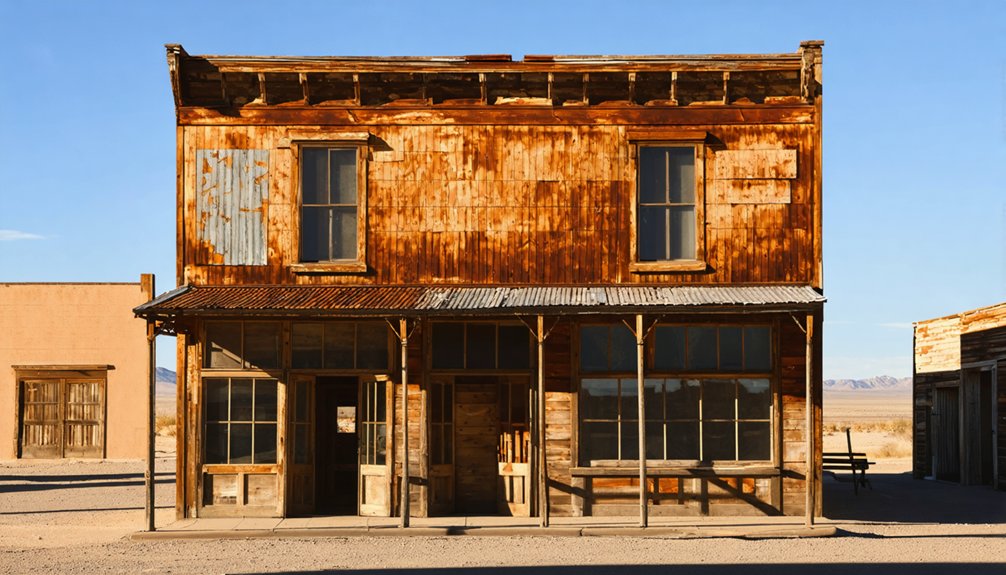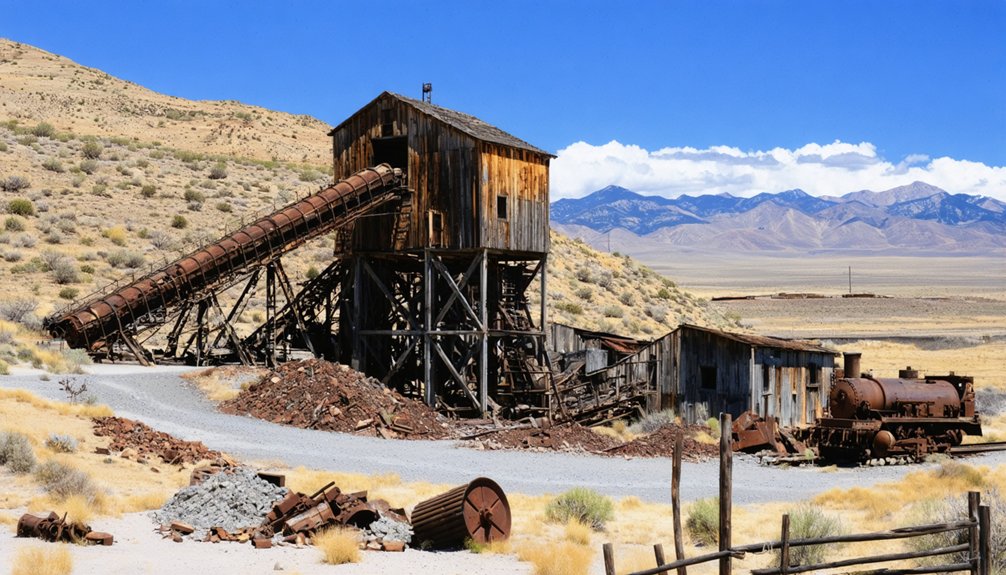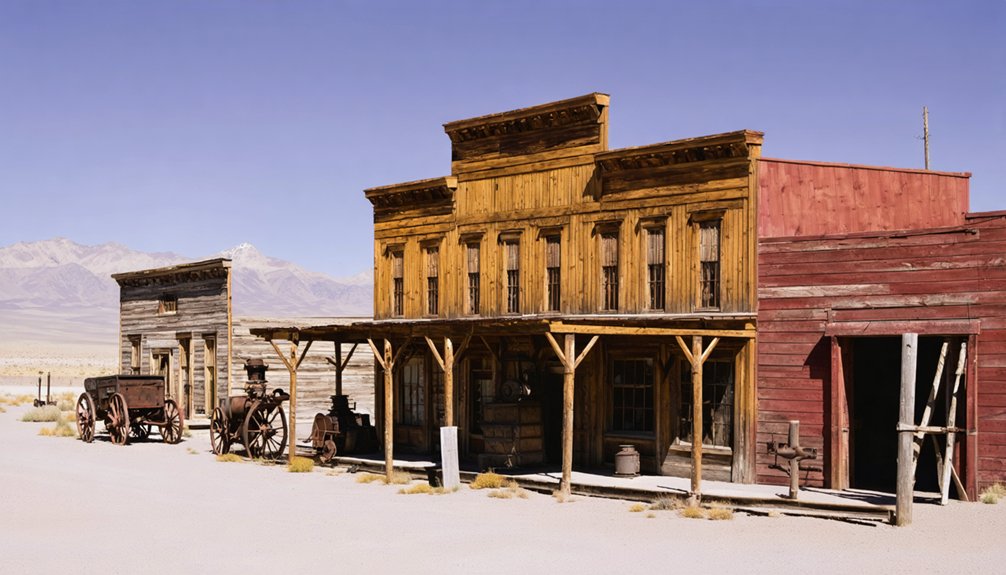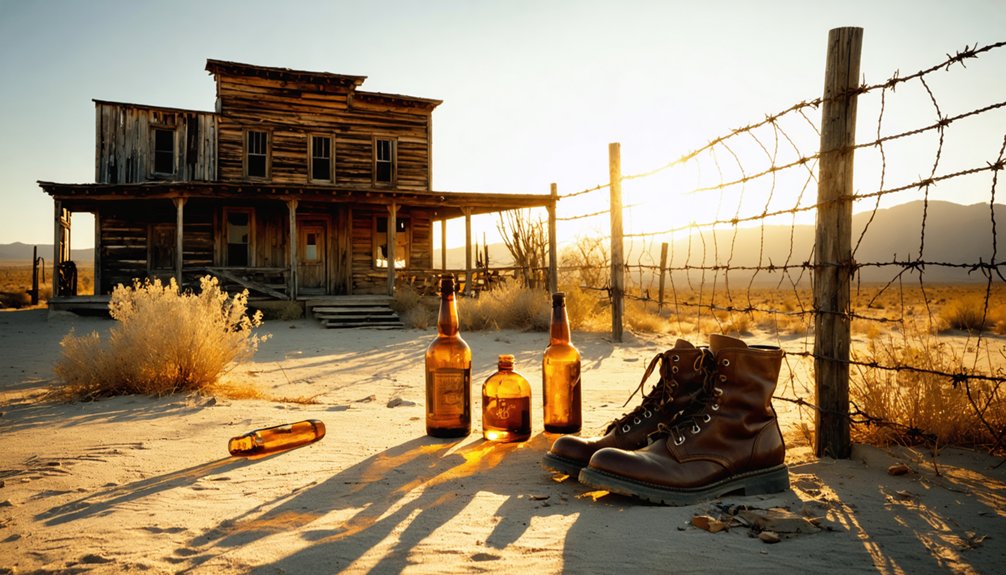Nevada’s best-preserved mining towns include Virginia City (home of the $400 million Comstock Lode), Eureka (America’s first silver-lead center), Tonopah (with its $150 million silver output), Goldfield (once Nevada’s largest city), Pioche (the “Wildest Town”), Rhyolite (with its iconic ruins), and Thompson (showcasing copper heritage). You’ll find 19th-century architecture, original mining equipment, and centuries-old tunnels that transport you back to the frontier’s mineral rushes and boom-bust economic cycles.
Key Takeaways
- Virginia City features hundreds of preserved 19th-century buildings and remains a premier example of Nevada’s silver mining heritage.
- Eureka is among America’s most intact 19th-century mining towns, with preserved brick buildings including the Opera House and County Courthouse.
- Tonopah’s Historic Mining Park spans 100 acres with original equipment and restored mining sites from its $150 million silver boom.
- Goldfield offers Florence Mine tours showcasing original mining operations and features architectural landmarks like the Goldfield Hotel.
- Pioche, Rhyolite, and Thompson each preserve unique aspects of Nevada’s mining history, from silver operations to copper processing sites.
Virginia City: Silver Legacy of the Comstock Lode
The monumental discovery of the Comstock Lode in June 1859 transformed Nevada’s Virginia Range into the epicenter of America’s most significant 19th-century mining boom.
You’ll find Virginia City perched 35 miles southeast of Reno, where miners once extracted millions from 3,000-foot shafts beneath the streets.
The innovative mining techniques pioneered here—particularly Philip Deidesheimer’s square set timbering method—revolutionized deep mining operations worldwide. This engineering marvel prevented cave-ins in the fault fissure deposits that characterized the Comstock’s geology.
The economic impact was staggering: the 2½-mile deposit yielded nearly $400 million in silver and gold, directly financing Nevada’s 1864 statehood and Civil War efforts.
Walking Virginia City today, you’re surrounded by hundreds of preserved 19th-century buildings that housed 25,000 residents at its peak—testament to when the Consolidated Virginia Mine alone produced $3 million monthly for three consecutive years. The Virginia and Truckee Railroad was instrumental in connecting this Western boom town to essential resources and markets.
Eureka: The Well-Preserved Lead Mining Capital
When you explore Eureka, you’ll discover a town that produced over 225,000 tons of lead between 1870-1890, making it America’s first significant silver-lead mining center.
The town’s remarkably preserved 19th-century brick buildings, including the Opera House and Jackson House Hotel, offer authentic glimpses into Nevada’s second richest mining district. The well-preserved historic mining town was established in 1864 and received its name from the Greek term meaning “I have found it”.
Eureka’s economic fortunes were transformed by transportation infrastructure, particularly the Eureka and Palisade Railroad, which facilitated ore shipment and earned the town its nickname as the “Pittsburgh of the West.” At its peak in 1878, Eureka boasted 16 smelters processing 745 tons of ore daily, reflecting the extraordinary scale of mining operations that once defined this historic town.
Lead Production Peak
While many Nevada mining towns rose and fell with the discovery of precious metals, Eureka distinguished itself as Nevada’s lead mining capital during the latter half of the 19th century.
The district achieved peak production in 1878, extracting over $5 million worth of ore and supporting a population exceeding 9,000 residents.
The economic significance of Eureka’s lead mining operations was substantial. As Nevada’s second richest mineral producer, trailing only the Comstock Lode, the district featured fifty mines yielding exceptionally high-grade ore containing 15-60 percent lead. The district’s rich mineralization consisted primarily of argentiferous and auriferous galena, making it valuable for both lead and precious metals production.
What made Eureka particularly profitable was its self-fluxing ores that contained sufficient iron and silica to eliminate the need for imported flux during smelting. By 1878, sixteen furnaces processed up to 700 tons of ore daily, cementing Eureka’s position as a premier lead producer.
This robust mining industry earned Eureka the nickname “Pittsburgh of the West” due to its extensive smelting operations that dominated the landscape and economy.
Remarkably Intact Architecture
As visitors traverse Eureka’s historic streets today, they’ll encounter one of America’s most remarkably intact 19th-century mining towns, preserved largely due to a devastating 1879 fire that ironically guaranteed the town’s architectural legacy.
The resulting brick and stone structures—featuring distinctive iron shutters and doors—exemplify architectural significance rarely found in comparable mining settlements. The two-story Eureka County Courthouse, Opera House, and Sentinel newspaper building stand as testimonies to historic preservation catalyzed by economic circumstances rather than deliberate conservation policies. These buildings stand among the most notable historic buildings in the entire state of Nevada. The beautifully restored Jackson House Hotel remains a centerpiece of the town’s historical offerings for visitors exploring Nevada’s mining heritage.
Limited capital for new development, coupled with mining’s decline in the 1970s, paradoxically protected Eureka’s historical integrity. Later gold mining revenues funded restoration projects, while the town’s modest population guaranteed minimal modern encroachment.
Underground elements, including mysterious tunnels and arches, add further intrigue to this exceptional architectural time capsule.
Railroad Economic Impact
The Eureka & Palisade Railroad, organized in 1873, transformed Eureka from an isolated mining settlement into Nevada’s “second town of importance” through its strategic connection to the Central Pacific Railroad at Palisade.
This railroad connectivity revolutionized the region’s economic potential, enabling efficient transport of silver and lead ores while attracting industrial development. The town’s sixteen smelters became a crucial part of the mining infrastructure, processing the valuable ores extracted from the surrounding district. The railroad’s operations peaked with the transport of ore from the Ruby Hill mines, but began declining by the mid-1880s as mineral production in the area waned.
Tonopah: Active Community With Rich Silver Heritage
Tonopah stands as one of Nevada’s most remarkable silver mining success stories, beginning with Jim Butler’s fortuitous discovery of high-grade silver ore at Tonopah Springs in May 1900. This discovery launched a 40-year production boom that yielded an astounding $150 million, with peak annual output reaching $10 million in 1913.
Today, you’ll find Tonopah’s mining heritage meticulously preserved at the Historic Mining Park, spanning over 100 acres with original equipment and restored mining sites. The landmark Mizpah Hotel stands as evidence to the town’s prosperous past.
With approximately 2,500 residents, Tonopah remains the vibrant seat of Nye County, where community events regularly celebrate its silver legacy. Despite the industry’s decline after World War II and unsuccessful revival attempts, including Howard Hughes’ 1968 investment, Tonopah’s historical significance endures through its well-maintained structures and exhibits.
Goldfield: “Greatest Gold Camp” With Surviving Historic Structures

When you visit Goldfield, you’ll marvel at its preserved early twentieth-century architecture, including the grand Goldfield Hotel which exemplifies the town’s former wealth during its $86 million gold production era.
You’ll encounter significant labor history at every turn, as the town witnessed major strikes that ultimately contributed to its decline from Nevada’s largest city to today’s living ghost town.
The Florence Mine offers tours that provide firsthand insights into the mining operations that once yielded over $10,000 in ore daily, connecting visitors directly to the economic engine that built this “Queen of the Mining Camps.”
Lavish Gold Rush Architecture
Richly emblematic of Nevada’s gilded age, Goldfield’s architectural landscape stands as perhaps the most impressive representation to mining wealth in the American West.
The town’s rapid architectural evolution from simple dugouts to magnificent structures mirrors its explosive economic growth following the 1902 gold discovery.
When you visit Goldfield, you’ll encounter:
- The opulent Goldfield Hotel (1908) featuring mahogany paneling, gold-leaf ceilings, and one of the first Otis elevators west of Mississippi
- The Nixon and Wingfield Block, symbolizing consolidated mining wealth
- The Esmeralda County Courthouse adorned with Tiffany lamps
- The Santa Fe Saloon (1905) with original Brunswick Bar and Western wood sidewalks
These surviving structures aren’t mere buildings but physical manifestations of freedom and opportunity that characterized America’s last great mining frontier.
Major Labor Strike History
While Goldfield’s architectural grandeur illustrates the town’s wealth, its dramatic labor conflicts reveal the social tensions underlying Nevada’s mining boom.
The town witnessed unprecedented labor disputes when the Western Federation of Miners established Union No. 220 in 1904, soon rivaled by the radical Industrial Workers of the World (“Wobblies”).
When George Wingfield consolidated mining operations in 1906, tensions escalated dramatically. Union conflicts erupted over high-grading prevention measures and payment in paper scrip rather than gold-backed currency.
The situation reached its climax in December 1907 when Governor Sparks requested federal troops from President Roosevelt. The 300 soldiers who arrived enabled mine owners to lower wages and import scab labor.
Roosevelt’s subsequent investigation revealed the intervention was unnecessary, as earlier negotiations had achieved compromise. This dispute directly led to the creation of Nevada’s state police force.
Florence Mine Tours Available
Among Goldfield’s remarkable historic treasures, the Florence Mine stands as an exceptional opportunity for visitors seeking authentic mining history. This exceptionally preserved complex, once producing wealth equivalent to nearly a billion dollars today, now offers Historic Tours by appointment only.
When planning your Florence Mine excursion, note these essential details:
- Tours cost $20 per person for a personalized experience
- Owner Jon Aurich personally guides all visitors through the property
- Reservations are mandatory—call (702) 622-1344 to secure your spot
- The site features original buildings including the hoist house, mill, and blacksmith shop
You’ll explore one of Nevada’s most significant gold discoveries from 1902, complete with original equipment and structures that have withstood a century of desert conditions—a true time capsule of American mining heritage.
Pioche: Mining Town Marked by Boom-Bust Cycles and Preserved Relics

Deep in the rugged Pioche Mountains of southeastern Nevada, the town of Pioche stands as a tribute to the dramatic boom-bust cycles that characterized Western mining towns in the late 19th century. This boomtown legacy began with silver ore discoveries in 1863-1864, reaching its zenith by 1872 when over 7,000 inhabitants fueled the extraction of $5 million in silver.
You’ll find extensive mining infrastructure still preserved throughout the area, including abandoned shafts, processing sites, and railroad remnants. The town, once nicknamed “Wildest Town in the Silver State,” extracted approximately 3.2 million tons of ore before operations ceased around 1959.
Today, you can explore the Lincoln County Museum‘s exhibits documenting Pioche’s tumultuous history or visit original mining sites like Treasure Hill and Volcano Mine—physical representations to Nevada’s mineral-rich past.
Rhyolite: Ghost Town Ruins From the Early 20TH Century Gold Rush
Located in the desolate Bullfrog Hills of southern Nevada, Rhyolite exemplifies the meteoric rise and fall characteristic of early 20th century gold rush settlements. Founded in 1904 following Frank Harris and Ernest Cross’s gold discovery, this boomtown rapidly expanded to 5,000 residents before its complete abandonment by 1924.
The town’s ruins now attract ghost town tourism enthusiasts seeking connections to Nevada’s mining heritage:
- The three-story John S. Cook Bank building, once symbolizing Rhyolite’s economic prosperity
- The famous Bottle House, restored in 1925 by Paramount Pictures’ parent company
- Railroad depot that later transformed into Rhyolite Ghost Casino
- Water system infrastructure that supported advanced mining technology and operations
While Rhyolite’s gold-fueled prosperity lasted less than a decade, its remarkably preserved structures offer unparalleled insight into early 20th century mining community development.
Thompson: Remnants of a Copper Company Town in Mason Valley

Thompson stands as a demonstration to Nevada’s copper mining legacy, established in the early 1900s amid the mineral-rich Mason Valley.
Nevada’s mining towns serve as silent monuments to the copper-driven ambitions that once transformed its rugged landscape.
When you visit today, you’ll find the ghostly remnants of William Boyce Thompson’s ambitious copper enterprise, which once processed 1,000 tons of ore daily through its dual smelters constructed in 1912.
As you explore the site, you’ll notice the planned two-block street grid where over 350 residents lived by 1914, supporting the massive mining infrastructure that defined this company town.
The collapsed smokestacks and deteriorating foundations document Nevada’s boom-and-bust economic pattern characteristic of its copper heritage.
Thompson exemplifies how mining towns flourished briefly then faded as operations ceased, leaving behind physical evidence of an industrial era that transformed Nevada’s economy before ultimately surrendering to time.
Frequently Asked Questions
Are There Any Accessible Mine Tunnels Open for Public Tours?
Yes, you’ll find accessible mine tunnels offering guided tours at Empire Mine State Park, Ponderosa Saloon’s Best & Belcher Mine, Tonopah Mining Park, and occasionally the historic Sutro Tunnel.
What Safety Precautions Should Visitors Take When Exploring Mining Towns?
Always wear safety gear including sturdy boots and helmets. Maintain wildlife awareness, particularly for snakes. Bring water, stay on marked trails, and don’t enter unstable structures or abandoned mine shafts.
When Is the Best Season to Visit Nevada’s Historic Mining Towns?
Spring and fall offer ideal conditions: spring delivers wildflowers alongside moderate temperatures (60-80°F), while autumn presents vibrant colors with fewer crowds. You’ll enjoy enhanced photographic opportunities and fully operational visitor services during these seasons.
Are Metal Detectors Allowed in These Historic Mining Areas?
No, you’re not permitted to use metal detectors in Nevada’s historic mining areas. Metal detecting regulations and historical preservation policies strictly prohibit this activity to protect archaeological resources under federal and state law.
Do Any Towns Offer Overnight Stays in Historic Mining-Era Buildings?
Like stepping into a time machine, you’ll find historic accommodations in Goldfield, Gold Point, Virginia City, and Eureka where you can rest your head amid authentic mining heritage surroundings.
References
- https://findingnevadawild.com/goldfield-the-old-west-lives-in-nevadas-best-ghost-town/
- https://ronhess.info/docs/report7_history.pdf
- https://www.rainesmarket.com/about-eureka.html
- https://www.thetravel.com/mining-towns-to-visit-in-nevada/
- https://nvtami.com/top-10-ghost-towns-nevada-northwest/
- https://westernmininghistory.com/state/nevada/
- https://myfamilytravels.com/historic-mining-towns-across-nevada-for-a-weekend-trip/
- https://nevadamagazine.com/article-tags/mining/
- https://savingplaces.org/stories/explore-wild-west-mining-history-in-nevada-ghost-towns
- https://en.wikipedia.org/wiki/Comstock_Lode



